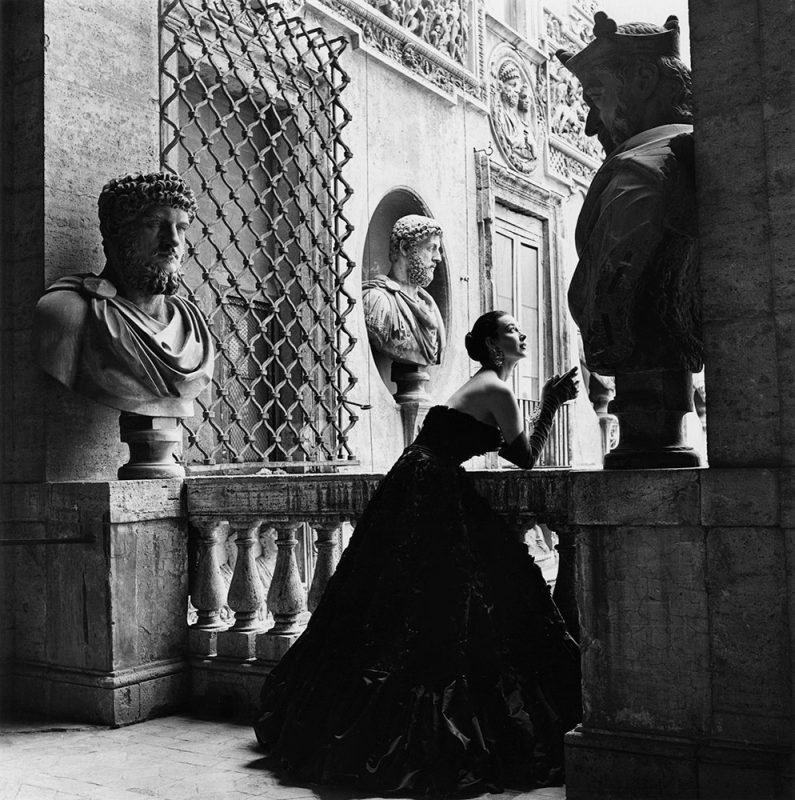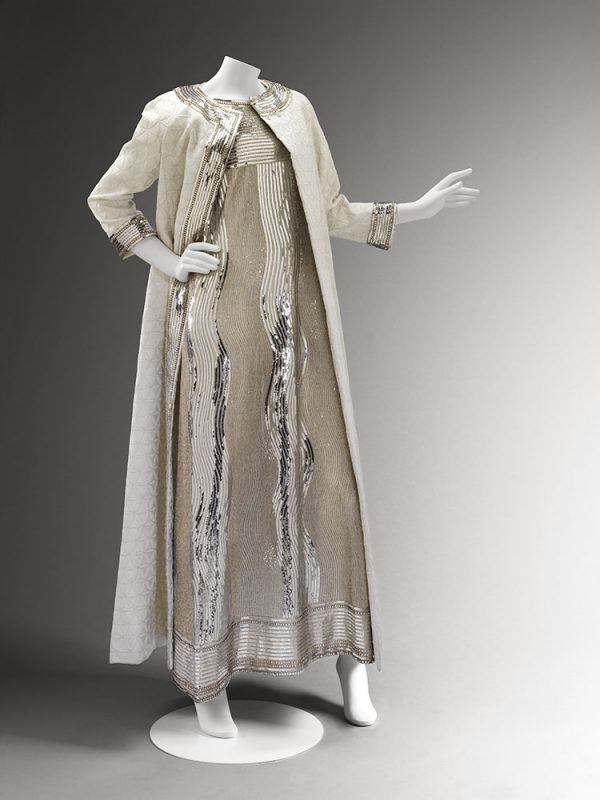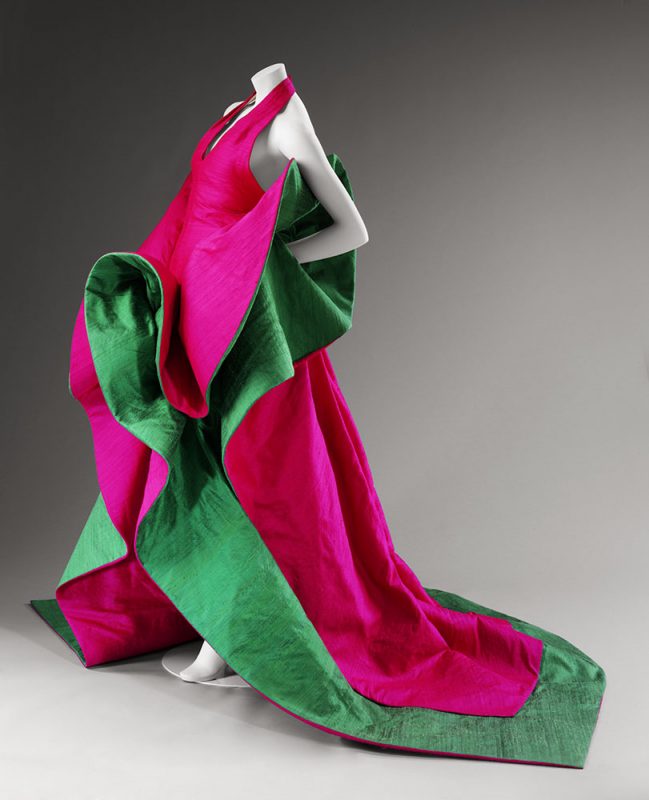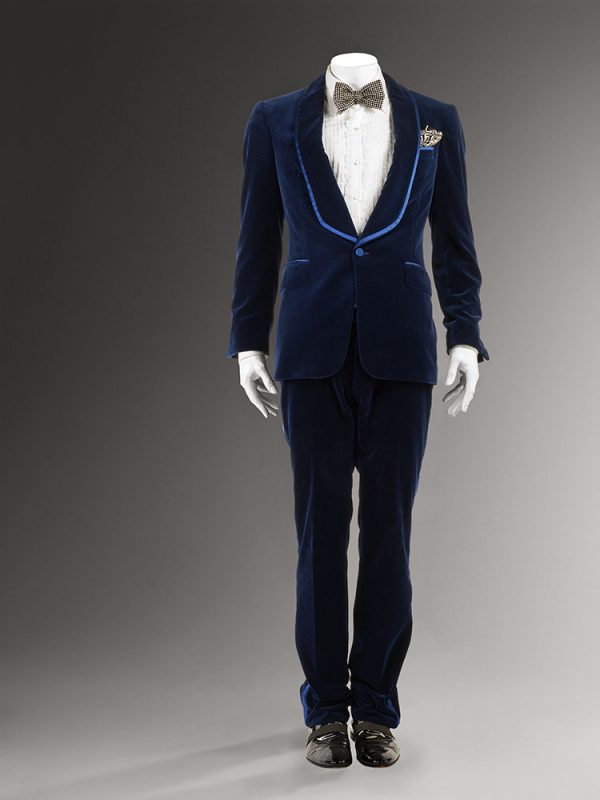Exhibition Preview
Italian Style: Fashion Since 1945 is the first major exhibition of its kind to examine Italy’s rich, arresting contribution to postwar fashion, showcasing the clothes that turned “Made in Italy” into the mark of style. From Armani to Valentino, Prada to Pucci, Italy’s iconic fashion houses have defined modern style, encompassing an innovative ready-to-wear industry, luxurious couture design, artisanal leather goods, and the country’s celebrated tradition of fine tailoring. “Italian Style” explores the social and industrial factors that enabled this success, from Italy’s post-war recovery to its preoccupation with high design to the interplay of craft specialists and manufacturing that became a hallmark of Italian production.
The exhibition includes about 100 ensembles from the collections of the Victoria & Albert Museum as well as other lenders, and is supplemented by film and fashion photography. Also featured are fashion accessories such as shoes, handbags, and jewelry, as well as examples of Italy’s tailoring and menswear designs.
Exhibition Preview

Salvatore Ferragamo’s intention in the 1920s was to make (in his words) “handmade shoes by mass production.” In the 1980s, his company was still flourishing under his widow, Wanda Ferragamo, who ensured the continued quality of his machine-produced goods. The two shoe designs here are classic styles featuring discrete elements of decoration, such as delicate inserts of silvered leather and a logoed fabric bow.
Salvatore Ferragamo with Audrey Hepburn at Palazzo Spini Feroni
in Florence, 1954
© Banca Dati dell’Archivio Storico Foto Locchi Firenze

By the late 1990s, Giorgio Armani had established a varied and influential stable of collections under his name—everything from suits and jeans to housewares. Public recognition came in the form of a career retrospective in 2000 at New York’s Guggenheim Museum. In 2005, after 30 years of designing ready-to-wear collections, Armani extended his brand further, founding a couture line called Armani Privé.
Evening dress
Armani Privé, Spring/Summer 2010
Lamé silk, Swarovski crystals and rhinestones
Courtesy of Giorgio Armani

Under creative director Frida Giannini, Gucci has made productive use of its own archive. This exhibition includes an updated version of the company’s 1960s “Jackie” bag (above), made famous by its namesake, Jacqueline Kennedy. The modern bag quotes the curved shape of the original and Gucci’s signature bamboo, but has now become fashionably oversized with prominent stitching.
Pigskin bag with bamboo handle
Gucci, 1960s
Given by Mrs. Lisa Monas
Photo © Victoria and Albert Museum, London

Princess Irene Galitzine was a Roman designer of royal Russian descent credited with creating the “palazzo pyjama” ensemble. This style of tapered trousers and boxy tunic became a chic choice for less formal evening wear. First Lady Jacqueline Kennedy wore Galitzine’s palazzo pyjamas for informal entertaining.
Given by Princess Irene Galitzine
V&A: T.221&A-197
Silk Palazzo Pyjamas
Irene Galitzine, 1963
Silk with beads and gold braid
Courtesy Historical Archive Maison Galitzine
Photo © Victoria and Albert Museum, London

Duchess Colonna di Cesarò, known as Simonetta, was imprisoned during the war for her anti-fascism. She opened her design studio in Rome in 1946 and showed at Giorgini’s first fashion show in 1951. She quickly developed an international clientele. This gown illustrates the elaborate, romantic evening wear associated with Simonetta’s early career.
Mila Schön
“Argento” Evening dress and coat, 1966
Worn and given by Princess Stanisław Radziwiłł
Photo © Victoria and Albert Museum, London

For Truman Capote’s infamous Black and White Ball (1966), Mila Schön dressed Lee Radziwill, sister of First Lady Jacqueline Kennedy. Radziwill usually favored French haute couture, but she chose an up-and-coming Italian designer for this high-profile event. The gown’s sinuous sequined pattern contrasts with the coat’s austere cut.
Worn and given by Princess Stanisław Radziwiłł
V&A: T.400&A-1974
Evening Gown of Embroidered Silk
Simonetta, Autumn/Winter 1952/3
Satin and silk chiffon
Image published in Harper’s Bazaar, October 1952
© Genevieve Naylor/courtesy Staley-Wise Gallery New York

Gian Paolo Barbieri is one of Italy’s most potent image-makers. Born in Milan in 1938, Barbieri’s lens has chronicled the changing nature of Italian fashion for decades. He has created images both for magazines such as Vogue Italia and for advertising campaigns. This advertising photograph for Gianfranco Ferré monumentalizes a Ferré specialty: the stylish white shirt.
Given by the photographer
V&A: E.406-2013
Advertising image for Gianfranco Ferré
Photograph by Gian Paolo Barbieri, 1991
Model, Aly Dunne
©GIANPAOLOBARBIERI

Capucci worked with Emilio Schuberth before establishing his own fashion house in 1950. He quickly became associated with an inventive, sculptural style. The multiple layers of this cocktail dress create the dramatic impression for which Capucci became known.
Istituti museali della Soprintendenza Speciale per il Polo Museale Fiorentino
Cocktail dress and velvet stole
Roberto Capucci, 1957
Silk with silk velvet stole
Courtesy Roberto Capucci Foundation
Photo © Victoria and Albert Museum, London

Sala Bianca
With wartime rubble still marking Italy’s cityscapes, former buying agent Giovanni Battista Giorgini launched Italy’s first internationally recognized fashion shows. The first took place in February 1951 at Giorgini’s home in Florence. The following year, he secured the use of the Sala Bianca or “White Hall,” an opulent, chandelier-lit gallery in Florence’s Pitti Palace.
Giorgini brought together leading designers from across Italy to show at the Sala Bianca. Over several days, he entertained his guests with dinners and elaborate balls. International buyers and the press viewed everything from swimwear to evening gowns.
The designers featured here presented collections in Giorgini’s first few shows. Some would later defect to Rome’s competing Alta Moda event. However it was Giorgini’s early Sala Bianca presentations that heralded the birth of Italian fashion.
Sfilata (fashion show) in Sala Bianca, 1955
Photo by G.M. Fadigati
© Giorgini Archive, Florence

From the mid-1990s to the mid-2000s, Gucci menswear embodied the Italian notion of sprezzatura, or dressing with a stylish nonchalance. Under Tom Ford, the design house produced wardrobes of trim, sleek suits and tailored separates. Suits such as this one were made for formal occasions, but suggested a less strict attitude toward conventional dress. Frequently featured in the press, Ford was Gucci’s own best menswear model.
Given by Gucci
V&A: T.7:1 to 11-2005
Man’s evening suit
Gucci, Autumn/Winter 2004/5
Silk velvet
Photo © Victoria and Albert Museum, London

This form-fitting, peek-a-boo evening dress exemplifies the overt sexiness of Tom Ford’s designs for Gucci. The designer’s canny advertising commissions from influential photographers such as Mario Testino helped him create a new model of femininity. Ford’s efforts helped reverse Gucci’s declining fortunes and in turn propelled him to international prominence.
Given by Gucci
V&A: T.6:1-2005
Peek-a-boo evening dress
Gucci, Autumn/Winter 2004/5
Silk jersey
Photo © Victoria and Albert Museum, London

Harnessing Italy’s famed leatherworking abilities, these elaborately embellished ankle boots are encrusted with beading, diamanté, and metallic embroidery. Such brash accessories provide the baroque flourish expected by Dolce & Gabbana loyalists across the globe.
V&A: T.70:1, 2-2012
